
06/26/2012
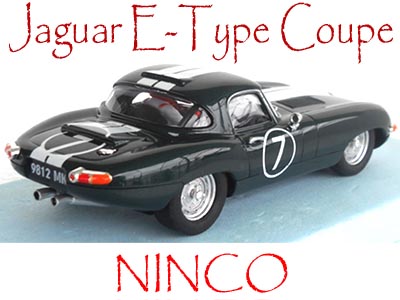
1/32 NINCO Jaguar E-Type Coupe Roadster
I came of driving
age in the mid 1960's (yes, some my best friends were actually Vikings). My
first car was a used British Racing Green Triumph Spitfire that I saved for
years to buy. But what I really wanted, what I dreamed about, was a Jaguar XKE.
Like that could ever happen! Well, now that NINCO has released the Jaguar E-Type
Coupe Roadster, I decided that I had waited long enough.
The 1:1 car represented by this NINCO model actually does exist and has a
curious, if not storied, history. Between 1963 and 1964 Jaguar built 12
"Lightweight E-Type" cars of various configurations that were intended for
racing and did find their way into races at Le Mans and Sebring, but without
much success. Regardless, the cars were bound to become collectors items and
there were many requests from collectors and wealthy sportsmen for a
Lightweight, however, Jaguar would or could not produce any additional beyond
the original twelve. But a few lucky souls managed to convince ($$) the factory
moguls to assemble some cars largely from whatever Lightweight parts remained in
the spares bin. These cars became known as "Semi Lightweight" and displayed
characteristics of E-Types from 1961 through 1964. The NINCO roadster is one of
the Semi Lightweights.
I don't know how many were made, but they were raced and also modified
for the street. Below is a Semi Lightweight in a recent vintage/historical race
that was listed as a 1961(?) model.
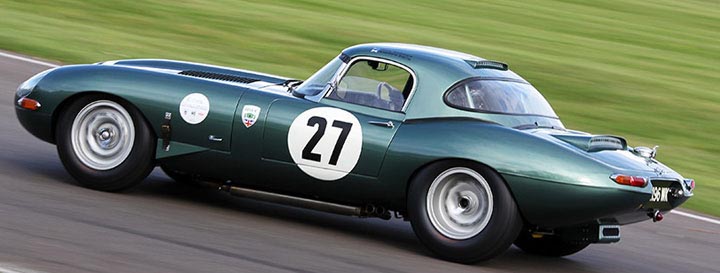
The decoration that NINCO has chosen is from the car in the following photos. It is a 1964 model. Although the NINCO version of the roadster's body seems to reflect some characteristics of various models between 1963 and 1964.
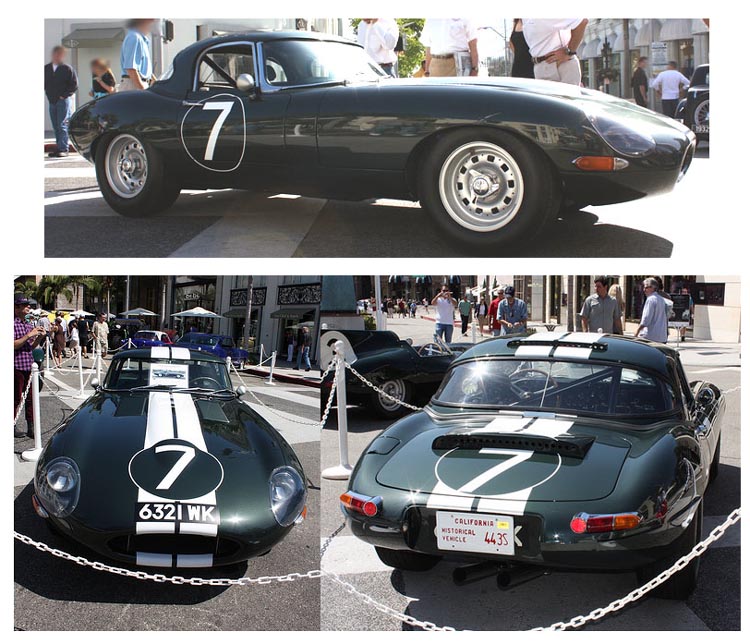
For those who may be interested, a brief historical narrative of the actual car that NINCO has modeled can be seen in this YouTube clip.
Upon removing the
NINCO E-Type Jaguar Coupe Roadster from its case and viewing it from various
angles up close, my first impression is that this is a striking model car.
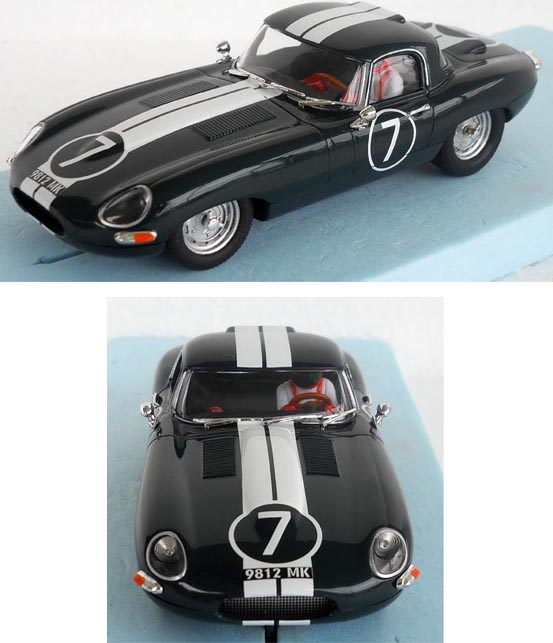
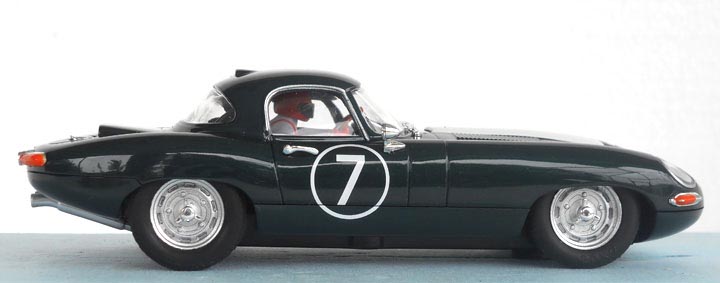
The stance is somewhat low, especially in front. But I think it makes the car look fast even while standing still. It may also enhance the handling a little.
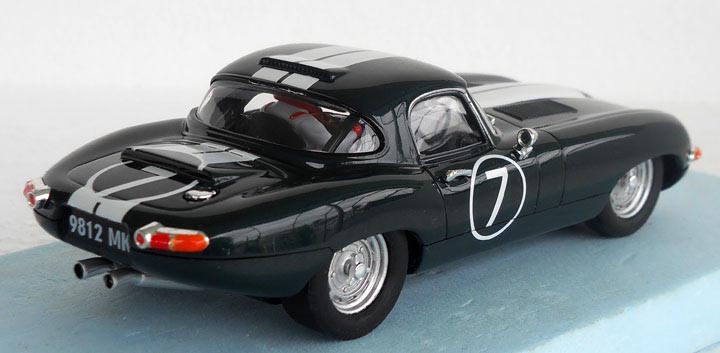
The paint, Tampo
and clear coat, if not perfect, are among the best in my collection. The white
racing stripes and numerals are uniformly solid with no evidence of bleed
through from the dark body color underneath. The British Racing Green seems
reasonably accurate to my eye and the overall finish has the deep reflection of
a highly polished multi coat auto finish. Fit of the upper and lower body panels
is very good with no sign of the small gap that could be present in some of the
earlier E-Type cars from NINCO. This is due in large part to the addition of two
screws that now connect the outside chassis (rocker) panels securely to the body
in this latest model. The glass and other external parts show no gaps or flaws
of any kind.
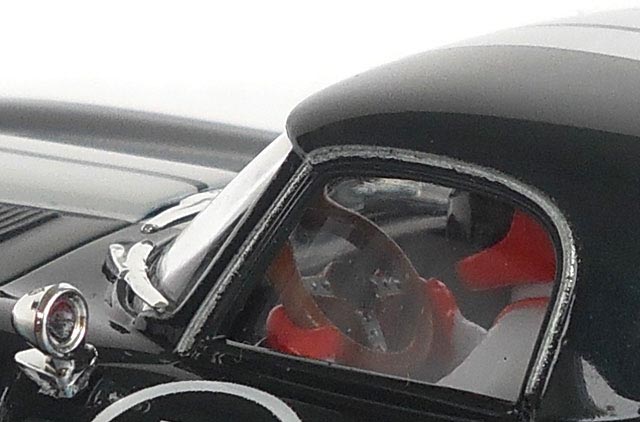
The decoration is
relatively simple but detail in every area is above average. Interior detail is
minimal but this is not surprising as it is a shallow "half pan" type, even
though the car is front motored. This, probably because of the very low profile
of the E-Type's body.
The wheels. Ah yes, the wheels. They appear to be the same (or very similar) as
those used in the NINCO Classic Porsches — 356 and 550 Spyder — with the
addition of a knock off hub. The photo below compares the 1:1 wheel (left in the
photo) to the model. For me, they are similar enough that it does not detract
from the model. But this is a personal preference and I understand how this
might be an issue for the scale conscious enthusiast.
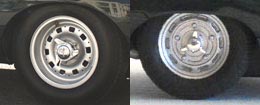
Speaking of
scale, I have heard that in the past some slot car manufacturers have
manipulated slot car dimensions beyond actual 1/32nd scale in order to enhance
performance on the track. Especially the cars' width. This results in cars that
may be larger than 1/32nd scale in one or more dimensions. NINCO has been taken
to task on this issue specifically over the width of their Classic Jaguar XK-120
model. So, I thought I would take some measurements of the NINCO E-Type and
compare them to the car's actual dimensions. A great tool for high precision
measuring of small irregular objects such as slot cars is the Hawk 5000 3D
non-contact optical measurement device.
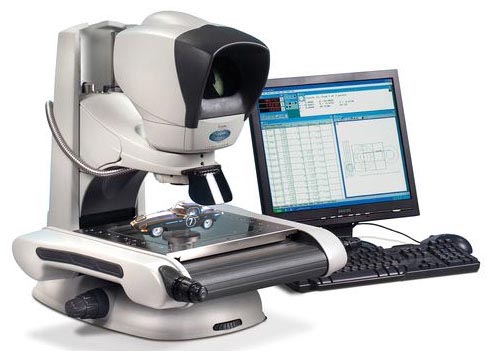
But I don't have
one, so I used this...

The following table lists the measurements for the 1:1 E-Type compared to the NINCO E-Type in millimeters. The 1:1 specifications are for the Fixed Head Coup (FHC) and were corroborated at three Web sites. There was never more than a few mm difference among the three sites. The numbers in parenthesis in the "NINCO E-TYPE" column are my measurements, multiplied by 32 on the left. The 1:1 number was then divided by the NINCO number. The resulting factor was then multiplied by 32 to calculate the exact scale. My measurements are reasonably accurate, subject only to things like parallax and old age. Anyway, for me this passes as a 1/32nd scale car.

PERFORMANCE
Removing the body reveals the identical chassis seen in the previous NINCO E-Type models, except for the addition of the two body mount screw holes on either side of the motor. The NINCO NC-9 "Sparker" motor, rated at 20K rpm and 145 gcm torque @ 14.8 volts, is mounted in a front motor configuration. The running gear is NINCO's time proven in-line 9 tooth brass pinion, 27 tooth standard crown setup. The guide is the standard suspension type and braids are standard, stiff, copper. A relatively strong narrow, but thick, bar magnet is present just beyond the chassis mid point toward the rear axle. The only other difference here is the wider rear tire, measuring about 9 mm wide compared to the 7 mm Classics in front.
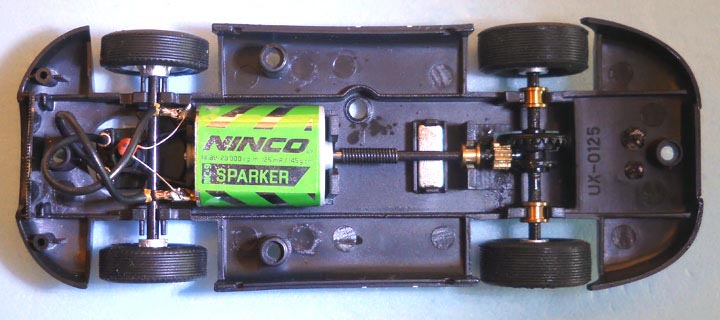
The front axle
snaps into the familiar NINCO axle holders but there is somewhat less vertical
axle movement when compared to the typical NINCO setup seen in the past. I
noticed that all three bushings (axle and drive shaft) fit snug in their cradles
but were not really tight. I think that they will eventually begin to loosen and
require adhesive to secure them, but more on this later.
Even before placing the car on the track, as I held the car in one hand and
gently turned the rear wheels, it was obvious that there was a problem somewhere
in the drive train. Regardless, without any tuning, adjustment or lubrication, I
placed the car in the slot of my twisty, bumpy, technical NINCO track configured
for analog operation and ran a few laps. It was impossible to complete a single
lap without the car surging and literally jumping out of the slot. Hopefully
this would turn out to be some sort of freaky problem and not characteristic of
the front motored drive train. And it was (a freaky problem, that is). A quick
check of the rear wheels revealed that they were both rubbing against the rear
area of the car's wheel wells. And I mean rubbing! They were literally
jammed up against the inside of the body, as shown in the following photo:
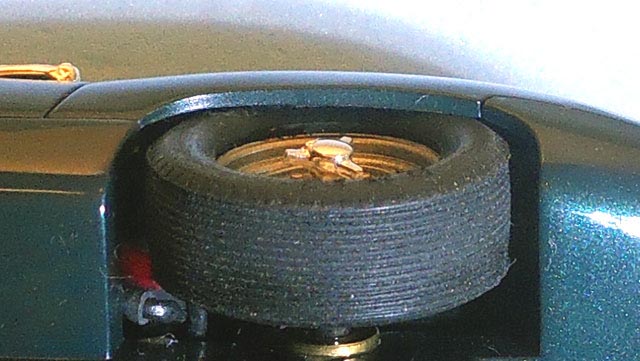
It appears that NINCO may have used the same rear axle and wheels that were used in the previous E-Type models. But the wider rear tires installed on this model simply protrude much too far for the body to accommodate. I tried pressing the wheels to move them in slightly and then reversing the tires on the wheels. Nothing helped. There are probably a few ways that this problem could be addressed, however, the solution that I chose was to trim the rear axle slightly. Trimming the axle did not change the appearance of the car in any way.
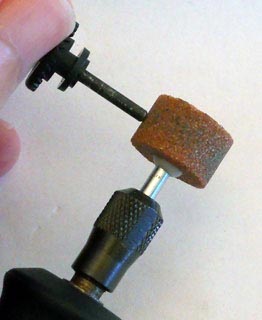
After removing
about 1/2 mm from each side of the axle with the cylindrical Dremel grinding
tool, there was no sign of tire rubbing and the car now ran much smoother. As of
this time I don't know whether this is a wide spread problem or limited to this
particular car.
Now that I felt confident that the car was ready for the track, I lubricated all
axle bushings, drive shaft and motor bushings. The gears appeared to be already
well greased. I also replaced the stock NINCO guide and braids with the ProRace
Suspension guide and ProRace soft, tinned braids, which is something that I
usually do with new NINCO cars.
I ran the car initially at 12 volts with the magnet in place. The E-Type Jaguar
can be driven very fast in this configuration, however, there is no way that I
could get the car to slide through corners the way that I would normally like.
Once adhesion is lost the car snaps out of the slot rather suddenly as would be
expected with a powerful, narrow magnet of this type. Frankly I could not get
used to the sight of the 1964 E-Type Jaguar rocketing around the track like a
modern LMP. But I think that those who run with the magnet will get quite
acceptable performance from this car.
Next, I removed the magnet and ran the car at 10 volts.The car ran predictably,
if not smoothly, and tended to stay in the slot. I did not get the sense of a
lot of vibration that is obvious in other front motored cars in my collection —
most notably, the Monogram cars of the same era as this E-Type. The relatively
narrow width belies the car's ability to power through standard R2 corners in a
subtle controlled slide with no impending tendency to tip or roll, within limits
of course. Braking was about what I would expect for this type of setup, perhaps
a little better.
After about 100 or so laps of analog running to get the feel of the handling and
break the drive train in a little, it was time to install the N-Digital decoder
chip. I do not have lap timing in analog operation so, running in digital mode
allows the recording of lap times in order to provide some objective evaluation.
For the digitally afflicted among us, it should be noted that this car does not
present a particularly easy conversion to digital operation.
For the N-Digital conversion, after a fair amount of trial and error, the only
place that the decoder chip will fit is on the side, just in front of the rear
wheel well. And the chip must be removed from its protective plastic case. To
protect against inadvertent electrical or metal contact, the chip is wrapped in
electrical tape (see the red arrow in the photo below). In this position, the
chip's input leads are too short to reach the guide terminals. Fortunately I
have a system of "quick connect" plugs that solves this problem by extending the
length of the leads (see the white arrow). Suffice to say that installing the
digital chip will require some form of fabrication effort. As for the other
major digital systems, I would guess that conversion would be even more of a
challenge given the need to install a photo cell in the area taken up by the
motor along with the chip itself. Chip size may also be an issue, especially for
Carrera.
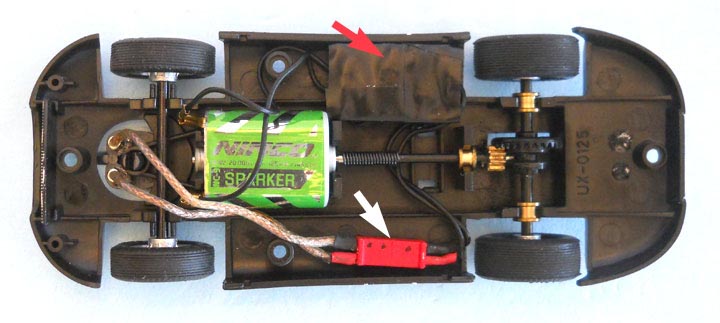
With the track configured for digital operation, I ran the NINCO E-Type for three 25 lap sessions in the 'professional' throttle profile and without the magnet. This would be roughly analogous to 11-12 volts analog with increased sensitivity in the lower end of the throttle curve on an adjustable (PWM) electronic controller. The lap times are shown in the following table:
Frankly, I expected a little better than this even from the front motor set up, but I was confident that the performance could be improved without drastic action. At this point I applied adhesive to the three bushing cradles and glued (tacked, actually) the rear wheels on the axle. The effect was immediate and lap times began to come down gradually as drive train and tires continued to break in. Lap times as of his review are in the next table:
These lap times should improve a little more as break in continues and I become more familiar with the car. I may experiment with some weight in various locations and perhaps some adhesive to keep the motor from rocking in the mount, but that will probably be it for tuning. I always maintain cars in a manner that allows a return to complete stock condition, whenever possible. But I am aware that a few of the more adept and adventurous racers have already modified the NINCO E-Type chassis to create significant improvements in performance.
In the line of NINCO Classics these E-Type Jaguars with their front motor set up are sort of odd men out. And with the 20K rpm/145 gcm motor I expected them to be too powerful for the other Classics. But now that I have these lap times to provide some perspective, I can see that they put this car in the middle of a relatively large pack of cars when running without the magnet:
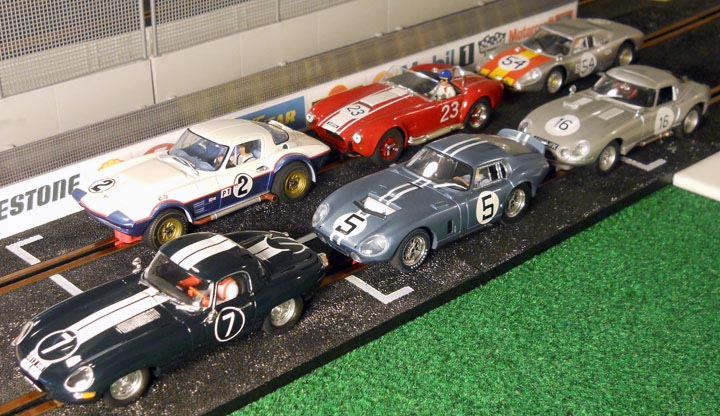
So, even though the E-Types may be somewhat of an odd fit in the NINCO Classic lineup, I believe that there is competition available. If not historical, at least performance compatible.
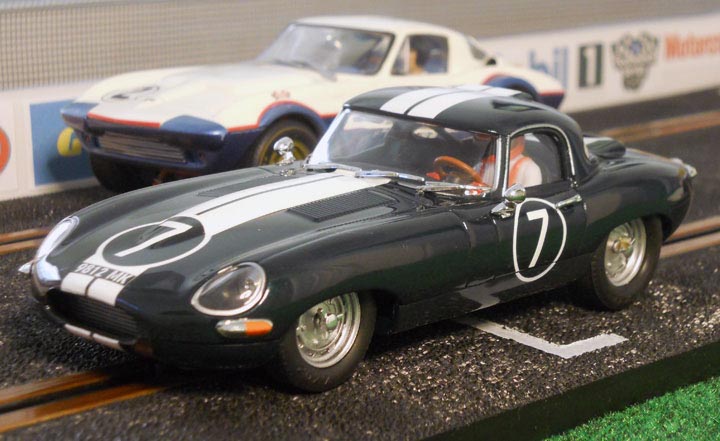
On balance I
believe that the NINCO Jaguar E-Type Coupe Roadster has a lot going for it. It
is a superb looking model car of any type. While not a big fan of front motored
slot cars, apart from the tire rubbing problem, the out-of-box performance of
this car, in my experience on NINCO track, is at least as good as FLY and
measurably better than Monogram front motored cars. And, with the notable
exception of the wheels, scale and historical accuracy should be more than
adequate for most slot racers and collectors.
The car appearing in this review was purchased from BRS Hobbies for about $68.
Michael Ashton
Thanks Go To BRS HOBBIES For Sponsoring This NINCO Review
Copyright © 2012 HomeRacingWorld.com All Rights Reserved